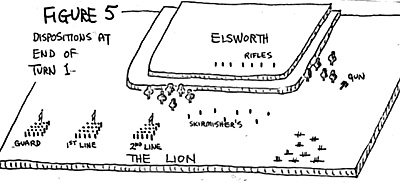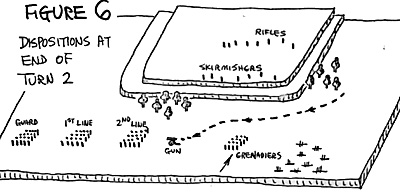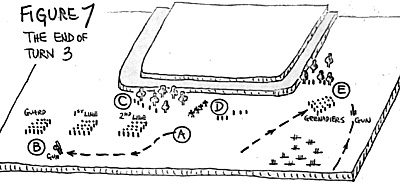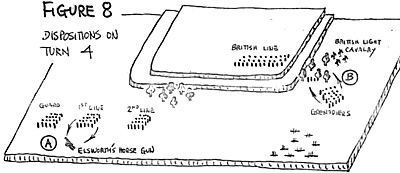And, speaking of formalized silliness, we engaged in that old Napoleonic standby, COLUMN, LINE & SQUARE (CLS), using Tom's 30mm Napoleonic army. I had brought Tom a slew of 30mm FUSILIER figures, the new name given to the line of 30mm castings formerly produced under the MINIFIG name. FUSILIERS sell in price comparable to 25mm figures; the intent of the firm producing them is to wean 15mm and 25mm gamers like Tom away from the smaller size castings and back into 30mm's.
Having been decisively defeated in the skirmish game depicting my storming ashore against Elsworth's defenses, I gathered a new accumulation of Army Points to Do It Again. Tom's available points totaled 44, mine were 66. We multiplied these by a common factor to enable us to use the CLS rules and the resultant forces were:
Esworth's Defenders
- 1 Horse Gun 5 figures
1 Btn British Infantry 33
1 Btn Portuguese Infantry 30
4 Coys British Rifles 12
3 Sqdrns Lt Cavalry 12
2 Sqdrns Scots Greys 6
1 Btn Russian Jaegers (militia) 16
= 114 Figures
The Lion's Invaders
- 1st French Line Btn 36
2nd French Line Btn 36
1 Btn French Grenadiers 24
1 Btn Prussian Guard 24
2 Sqdrns Prussian Kurassiers 6
2 Sqdrns French Dragoons 10
1 Horse gun 5
= 141 figures
 We played the scenario twice -- once for a practice run, the
second for real. In the first go, my 2 line battalions advanced
against the Russian militia in the woods and wiped them out while
my two Guard units went up the middle. See Figure 4.
We played the scenario twice -- once for a practice run, the
second for real. In the first go, my 2 line battalions advanced
against the Russian militia in the woods and wiped them out while
my two Guard units went up the middle. See Figure 4.
CLS provides horse guns with an unbelievable amount of maneuverability, and, strangely enough, our guns, after writing simultaneous orders for Turn 3,found themselves side by side just south of the woods concealing the British Rifles. I chose to fire at the woods, wiping out most of the Rifles with cannister, while Tom chose to fire at my gun, wiping out the artillery crew. His crew/)in turn, were quickly annihilated by the advancing Prussian Guard, and we both found ourselves without artillery.
All was going well for me when disaster struck in the form of the Scots Greys:
- a. The Greys, all 6 of them, meleed with my 10 Dragoons
and with some excellent Elsworth dice throwing, wiped out all
10. No Grey losses.
b. The Greys, on their bonus move, next encountered my 6 Prussian Kurassiers and, again, Elsworth's dice throwing saw them through. One Grey killed, and all 6 Kurassiers gone.
c. The remaining 5 Greys then slammed into my Prussian Guard and all 24 Guardsmen went to heaven, versus 4 Greys. One Grey survived, a battle weary warrior.
At this point in time I threw in the towel; with no artillery, no cavalry, and my Prussian Guard gone down the drain, my invasion attempt was brought to a halt. Thank heaven that this was only the first and practice, game!!
The second encounter, the real one, was fought the next day.
The orders of battle were the same as before, and on Turn 1, 3 infantry units advanced in column north towards the hill that commanded the field.
 The only units visible to my troops were Elsworth's Rifles, 4 companies worth, all
waiting on the hill, together with a limbered horse gun just to the east of the woods. The CLS
sequence employs fire after movement, and my forward skirmishers traded fire with the
Rifles. Figure 5 shows the dispositions at this time the Elsworth horse gun quickly put a ball
through my 2nd Line battalion. Figure 6, below, shows how we ended up after Turn 2.
The only units visible to my troops were Elsworth's Rifles, 4 companies worth, all
waiting on the hill, together with a limbered horse gun just to the east of the woods. The CLS
sequence employs fire after movement, and my forward skirmishers traded fire with the
Rifles. Figure 5 shows the dispositions at this time the Elsworth horse gun quickly put a ball
through my 2nd Line battalion. Figure 6, below, shows how we ended up after Turn 2.
The first phase of the CLS sequence belongs to the horse gun; it gets to perform 3 actions such as move, unlimber, and fire, before all other troops do anything. Figure 6 indicates that the horse gun moved forward in a most irritating manner; it was placed directly to the right flank of my 2nd Line battalion, ready to blast away enfillade.
What saved me was that the gun had fired on Turn 1; this meant that on Turn 2, it had to limber, move, and unlimber... these were the 3 actions allowed it on Turn 2, hence it couldn't fire. Also on Turn 2, my 3 battalions already on the field had orders to hold, while my 4th unit, one of converged Grenadiers, marched up the field as shown. CLS uses simultaneous movement effected by pre-turn order writing; I had told my Grenadiers to march on as they did... note that the horse gun, having moved first, was already in place as the Grenadiers marched by.
 But orders
are orders; the grenadiers couldn't do a thing to the enemy gun crew as they passed by but tip
their hats. Formalized silliness???
But orders
are orders; the grenadiers couldn't do a thing to the enemy gun crew as they passed by but tip
their hats. Formalized silliness???
In the meantime, my skirmishers advanced on the Rifles, and in the-exchange of fire, the Rifles went below 50% of their original unit strength. Under CLS rules, reaching the 50% mark requires an immediate Combat Efficiency (CE) test.
For this CE test, a six-sided die is thrown:
- 1,2 ... Unit stands
3,4 ... Unit falls back
5,6... Unit routs
The Rifles' die roll was a 3; they fell back - off the board and were seen no more.
Note in Figure 6, turn 2, that I still only saw 2 of Tom's units. He was keeping his others, Wellington fashion, over the crest of the hill. Figure 7 shows where they were for Turn 3.
 Figure 7
Figure 7
- Point A: The first phase of the sequence permitted the Elsworth
horse gun to fire, limber, and move, which it did. My 2nd
Line was blasted in the right ear with cannister. CLS
requires two 6-sided dice to be thrown; the total is the
number of casualties due to horse gun cannister fire. Tom
threw a measly 4 and my 2nd Line lost only 4 figures.
Point B: The gun then limbered and moved to this point where it remained limbered behind my lines, most disconcerting.
Point C: Elsworth's militia revealed themselves in the w
Point D: Out of the same wood which held the militia, some light cavalry charged my skirmishers as they were pulling back to rejoin their parent units. The light cavalry never made contact; pass-through fire got 'em
Point E: My Grenadiers marched north-east. Remember that the horse gun moves first... I had thought Elsworth's gun, after firing at my 2nd Line, would retire to Point E, and I had written orders for my Grenadiers and my own horse gun (newly arrived), to converge on Point E. Tom's actual move to Point B took me by surprise. Instead of Tom's horse gun, the Grenadiers were met with fire from the British light infantry in the woods.
Note from the maps that that, for the first 3 turns, I was in no hurry to advance. The only offensive tactic on my part was the Grenadier's action to cut off the horse gun, and that failed miserably.
 Turn 4 (see Figure 8) started off in horrific fashion:
Turn 4 (see Figure 8) started off in horrific fashion:
- Point A: That damned horse gun of Elswortk's now began the sequence
by unlimbering, firing and limbering (3 actions). This
time the flank of my westernmost Guard unit was the target.
The cannister effect (2 six-sided dice) showed 5 Guardsmen
dead. I got off easy. But I had also ordered the 1st, Line
to about face and charge the gun. In effect, Tom had
trapped his gun behind my lines, boxing it in, and I took
full advantage of this. The horse gun crew quickly went
under beneath the enraged soldats of the 1st Line.
Point B: But Point B was where the critical action took place. Having been fired on from the woods last turn by the British lights, I ordered my Grenadiers to clear the woods, and they charged forward. Tom had brought the rest of his British line unit forward to hold the hill. They were now adjacent to the woods. Also in the woods unknown to me were 2 small units of British light cavalry. My Grenadiers took 'em all on.
Under CLS rules, all defending units within 6 inches of a melee are 'sucked' into 'he fight, whether they like it or not. And so my Grenadiers contacted the British light infantry. One or two dice throws and the British lights were gone. Still breathing easily, the Grenadiers took on the British cavalry. A wee bit more difficult than the light infantry, but they, too, went under. Now it was the British line's turn, and to Elsworth's horror, in their morale throw, the British line unit routed back!!
As they routed, they passed near 2 hidden units. One of these, a Portuguese line battalion, also routed!! The only unit that Elsworth had that was of any value was his Scots Greys... the fierce fellows that had done me in during our practice game.
And so Big E conceded the game; the battlefield was mine ... the Lion had emerged victorious! But then... could there have been any other logical outcome??
More And a Good Time Was Had By All
-
UK Wargaming: Introduction
Oxford Polytechnic Wargames Club: WWII and Samurai
Napoleonic Battle: Column, Line, Square
Monopoly
Back to PW Review December 1981 Table of Contents
Back to PW Review List of Issues
Back to MagWeb Master Magazine List
© Copyright 1981 Wally Simon
This article appears in MagWeb (Magazine Web) on the Internet World Wide Web.
Other military history articles and gaming articles are available at http://www.magweb.com